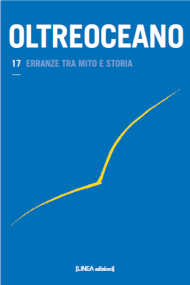Il mito dell’emancipazione nera in due romanzi della Harlem Renaissance
DOI:
https://doi.org/10.53154/Oltreoceano5Parole chiave:
New Negro Movement, Harlem Renaissance, contro-mitoAbstract
Questo saggio esamina due romanzi della Harlem Renaissance: There Is Confusion (1924) di Jessie
Redmon Fauset e Infants of the Spring (1932) di Wallace Thurman. In entrambi è possibile trovare una rappresentazione contro-mitica delle speranze di emancipazione rispetto ai canoni e ai valori bianchi che la cultura afroamericana nutrì, e solo in parte realizzò, tra gli anni Venti e Trenta del Novecento.
The Myth of Black Emancipation in Two Novels of the Harlem Renaissance
This essay focuses on two novels of the Harlem Renaissance: Jessie Redmon Fauset’s There is
Confusion (1924) and Wallace Thurman’s Infants of the Spring (1932). Both novels offer a counter-
mythical representation of black artists’ hope to emancipate themselves from white canons and
values in the 1920s and 1930s.
Downloads
Riferimenti bibliografici
Dickson-Carr, D. (2001): African American Satire: The Sacredly Profane Novel. Columbia: University of Missouri.
Dickson-Carr, D. (2015): Spoofing the Modern: Satire in the Harlem Renaissance. Columbia: University of South Carolina Press.
Fauset, J.R. (1990): There Is Confusion (Thadious M. Davis Ed.). Boston: Northeastern University Press.
Ganter, G. (2008): Decadence, Sexuality, and the Bohemian Vision of Wallace Thurman. In A. Tarver and P.C. Barnes (Eds.), New Voices on the Harlem Renaissance: Essays on Race, Gender, and Literary Discourse (pp. 192-213). Madison: Fairleigh Dickinson University Press.
Herring, T.S. (2001): The Negro Artist and the Racial Manor: Infants of the Spring and the Conundrum of Publicity. Rivista African American Review, 35 (4), pp. 581-597.
Hutchinson, G. (2004): The Novel of the Negro Renaissance. In M. Graham (Ed.), The Cambridge Companion to the African American Novel (pp. 50-69). Cambridge, Cambridge University Press.
Kuenz, J. (1999): The Face of America: Performing Race and Nation in Jessie Fauset’s There Is Confusion. Journal The Yale Journal of Criticism, 12, 1, pp. 89-111.
Levering Lewis, D. (1989): When Harlem Was in Vogue. Oxford: Oxford University Press.
Levison, S. (2000): Performance and the Strange Place of Jessie Redmon Fauset’s There is Confusion. MFS Modern Fiction Studies, 46, 4, pp. 825-848.
McDowell, D. E. (1981): The Neglected Dimension of Jessie Redmon Fauset. Afro-Americans in New York Life and History (1977-1989), 5, 2, pp. 33-49.
McKaye, C. (1993): Home to Harlem. Wayne F. Cooper (Ed.). Boston: Northeastern University Press.
Miller, N. (1996): Femininity, Publicity, and the Class Division of Cultural Labor: Jessie Redmon Fauset’s There Is Confusion. Journal African American Review, 30, 2, pp. 205-220.
Ross, Marlon B. (2013): Racial Uplift and the Literature of the New Negro. In G. A. Jarrett (Ed.), A Companion to African American Literature (pp. 151-167). Oxford, Wiley-Blackwell.
Schenck, M. J. (2001): Jessie Fauset: The Politics of Fulfillment vs. the Lost Generation. South Atlantic Review, 66, 1, pp. 102-125.
Thurman, W. (2006): Infants of the Spring (Amritjit Singh Ed.). Boston: Northeastern University Press.
Thurman, W. (2008): The Blacker the Berry. New York: Dover.
Walker, D. E. (1998): Exploding the Canon: A Re-examination of Wallace Thurman’s Assault on the Harlem Renaissance. Western Journal of Black Studies, 22, 3, pp. 153-158.
Watts, E. K. (2012): Hearing the Hurt: Rhetoric, Aesthetics, and Politics of the New Negro Movement. Tuscaloosa: University of Alabama Press.
Downloads
Pubblicato
Come citare
Fascicolo
Sezione
Licenza

Questo lavoro è fornito con la licenza Creative Commons Attribuzione - Non commerciale - Condividi allo stesso modo 4.0 Internazionale.
Gli autori si impegnano a rispettare le seguenti condizioni, che s’intendono accettate al momento della sottomissione per la stampa dei propri contributi.
L’invio di un testo implica che esso sia inedito e non in attesa di essere pubblicato altrove.Gli autori si impegnano a rispettare le seguenti condizioni, che s’intendono accettate al momento della sottomissione per la stampa dei propri contributi.
- Qualora venga accettato, l’autore conferisce all’editore il diritto di pubblicarlo e distribuirlo sia in forma cartacea che nell’edizione elettronica in rete. Gli articoli pubblicati saranno scaricabili e resi disponibili in open access.
- Purché segnali correttamente che la prima pubblicazione è avvenuta sulla rivista «Oltreoceano. Rivista sulle migrazioni», l’autore ha facoltà di: a) riprodurre l’articolo in estratti separati o raccolti in volume; b) pubblicare l’articolo nel proprio sito personale o in quello di corsi di insegnamento purché si tratti di siti di natura non commerciale; c) depositare l’articolo in archivi online di carattere non commerciale, legati all’istituzione di appartenenza o come parte di progetti di diffusione non commerciale e open access dei lavori scientifici.
Non è consentita l’utilizzazione dei contributi da parte di terzi, per fini commerciali o comunque non autorizzati. L’editore declina ogni responsabilità sull’uso non autorizzato del materiale pubblicato sulla rivista.













